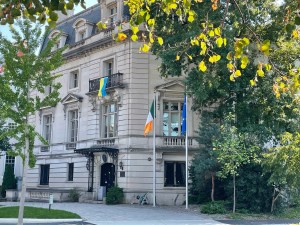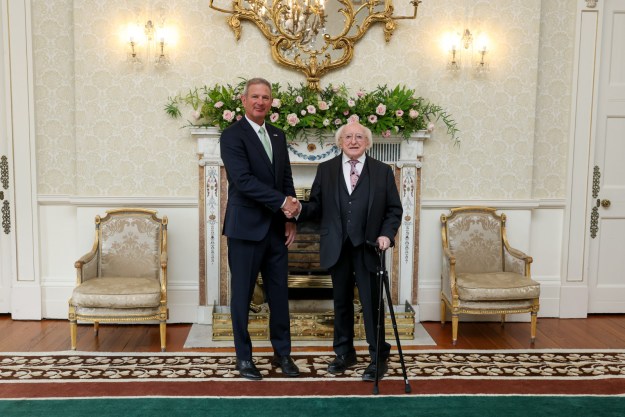The Embassy of Ireland USA in Washington, D.C. has relocated from an historic early 20th century mansion to a recently renovated 1966 office building steps from the White House. The old location was the home of the Irish republic in the American capital for 75 years.
“We begin to write the next chapter in the great story of Ireland-U.S. relations,” Tánaiste and Minister for Foreign Affairs Simon Harris said during the Sept. 25 ribbon cutting at the new embassy offices at 1700 Pennsylvania Avenue NW.
Known as The Mills Building, the 11-story building was renovated in 2022. It is across the street from Lafayette Park and the two-block portion of Pennsylvania Avenue closed to vehicle traffic, between 17th and 15th streets.
Access to the White House is highly restricted to guided tour groups, though Irish dignitaries are welcomed to 1600 Pennsylvania Avenue every March. The grounds were officially closed by President Woodrow Wilson during the First World War. Fencing and other security measures began to appear during the 19th century.
As many readers will know, the White House was designed by the Irish-born architect James Hoban. Fewer readers will know the first official offices of the Irish Free State in Washington were located in the Munsey Building, 1321 E. St. NW, between 13th and 14th streets, not too far from the new embassy. Timothy A. Smiddy represented the state until 1929. The Irish National Bureau produced the Friends of Irish Freedom’s weekly News Letter in the Munsey Building from 1919 to 1922. Éamon De Valera also kept an office there during his 1919-1920 tour of the United States.[1]See my November 2020 post, “Washington, D.C.’s Irish hot spots, 1919-1921“.
“This will be an excellent base from which to grow our vital political, economic and cultural ties with the US over the years ahead,” Harris said of the new Irish Embassy, according to an official statement. He emphasized that Ireland is the fifth largest source of foreign direct investment in the US, and that Irish companies have created more than 200,000 American jobs.
Leaving Embassy Row
The Irish Embassy was previously located at 2234 Massachusetts Avenue NW, on Sheridan Circle, part of the city’s historic “Embassy Row.” The semidetached limestone residence was designed by William Penn Cresson in the Louis XVI manner. Completed in 1909, it is known as the Henrietta M. Halliday House, after the widow of a wealthy businessman. It is unclear if she ever lived in the house, which was sold in 1911.[2]”Henrietta M. Halliday House (Irish Chancery)”, HABS No. DC-261, Historic American Buildings Survey, Office of Archeology and Historic Preservation, National Park Service, U.S. Department … Continue reading

The former Irish Embassy in October 1924, with Irish and EU flags at right, Ukrainian flag draped from balcony.
The Irish government purchased the property for $72,000 in August 1949. At the time, Ireland’s presence in Washington was still described as legation. Three months later Irish Minister to Washington Seán Nunan welcomed Irish Minister of Agriculture James Dillon, who was visiting the city for an international conference.[3]”Society News”, (Washington) Evening Star, Nov. 30, 1949. In March 1950, John Joseph Hearne became the first Irish ambassador to Washington.
The property is assessed at $6,548,040, according to DC tax records. It is being sold by the commercial real estate firm CBRE, which says it has not set an asking price. The adjoining 2232 Massachusetts Ave. is being co-marketed by residential real estate firm Compass for $2,995,000. See their Oct. 6 press release. (This paragraph was updated from the original post.)
In December 2023, the Irish government purchased the nine-bedroom mansion at 2221 30th Street NW as its official ambassadorial residence. The $12.25 million sale price shaved more than $4 million off the $16.5 million list price. The state began renting the 15,000 square-foot mansion as it sold its former ambassadorial residence at 2244 S Street NW, known as the Frederic Delano House, after an uncle of U.S. President Franklin Delano Roosevelt. That property sold for $8 million in March 2024.
Exempt & delinquent taxes
The new Irish ambassador’s residence had an outstanding District of Columbia tax bill of $33,502 as of Sept. 30. A notice of $153,910 in delinquent taxes and penalties was sent by the District to the Irish government in April. More than $30,000 in late fees and interest had been assessed since the property was purchase in December 2023. The most recent statement, dated Aug. 4, shows that no new assessments or penalties have been levied against the property, which suggests an exemption is now in place. The Irish Embassy could not be reached through its general telephone number.
The former embassy property was exempt from taxes. More than 600 properties in the District owned by foreign governments accounted for $50.2 million in foregone tax revenue in 2019.[4]Lincoln Institute of Land Policy, May 2019, citing District of Columbia Office of the Chief Financial Officer 2018. The U.S. government owns some 2,800 properties exempt from District taxes, with an estimated market value of $52 billion, or $917.7 million in foregone property tax revenue annually. And then there are religious institutions, schools, and assorted non-profits, in addition to the District government’s own property, also exempt from taxes.
The Irish government’s tax-exempt status on other properties does not mean it automatically received a discount on a commercial lease, which I assume is the arrangement at The Mills Building. The U.S. State Department’s Office of Foreign Missions regulates such matters, which are more complicated than can be addressed here. Reciprocal treatment in the foreign country–in this case, the U.S. government in Ireland–is certainly a factor.
Personal note
On a personal note, I enjoyed visiting the former Irish Embassy on several occasions since I moved to Washington nearly 12 years ago. These opportunities came through my membership in Irish Network-DC, a professional and social group. The place certainly had the elegant feel of an earlier age, when the Society pages of DC dailies regularly reported the comings-and-goings of diplomats and other special guests. I visited the new ambassador’s residence once for an IN-DC event.
I live barely a five-minute walk from the now former embassy location. I enjoyed walking Irish visitors past the exterior, then continuing a few blocks further up Embassy Row to the small park centered by a statue of Robert Emmet.
At least Irish patriot remains in place.
References
| ↑1 | See my November 2020 post, “Washington, D.C.’s Irish hot spots, 1919-1921“. |
|---|---|
| ↑2 | ”Henrietta M. Halliday House (Irish Chancery)”, HABS No. DC-261, Historic American Buildings Survey, Office of Archeology and Historic Preservation, National Park Service, U.S. Department of the Interior, 1978. |
| ↑3 | ”Society News”, (Washington) Evening Star, Nov. 30, 1949. |
| ↑4 | Lincoln Institute of Land Policy, May 2019, citing District of Columbia Office of the Chief Financial Officer 2018. |



















